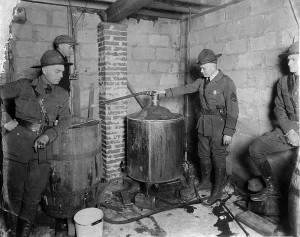This article is originally posted on the West Virginia Encyclopedia’s website and gives an excellent history of moonshine. Author attribution is listed below.
The making of illegal or moonshine whiskey has a long history in West Virginia and elsewhere. The word entered the English language about 1785 when white brandy was smuggled on the southeast England coast of Kent and Sussex. Those who made or transported the beverage worked under moonlight to escape the law. Moonshine is illegal because producers do not abide by state or federal laws regarding the licensure, manufacture, sale, and taxation of distilled spirits.
In West Virginia, field corn, soft creek water, and industrious farmers came together to make moonshine, sometimes also called mountain dew or white lightning. Moonshine is typically 100-proof whiskey, aged little or none, and was an important cash crop. So long as revenue agents did not cause trouble, making moonshine was an efficient and profitable way to market corn. With a good still, one-and-a-half bushels of corn was reduced to a gallon of whiskey, which was worth more than the grain itself and less bulky to transport.
From the mid-18th century, settlers from Scotland, Ireland, Wales, and England came to the mountains with distilling equipment and the necessary know how. They quickly adapted their Old World recipes to include American field corn. Whiskey was drunk in far greater quantities than today and used to barter for salt, nails, and taxes. Some used it to buy property, and a good copper still and the condensing coil or ‘‘worm’’ had considerable value themselves.
On March 3, 1791, soon after the colonies became a nation, Congress imposed the first taxes on stills and whiskey. Such laws caused the 1794 Whiskey Rebellion, an uprising in western Pennsylvania and parts of present West Virginia. The settlers, mainly Scotch-Irish, saw the tax as unfair. President Washington himself led troops to stop the rioting, and the federal government kept the tax in force for 11 years. Whiskey remained untaxed from then until 1862, except for three years following the War of 1812.
About 1910, states began to enact state prohibition laws in anticipation of the great national drought soon to follow. West Virginia prohibition took effect in 1914. Then, from 1920 until 1933 the U.S. government enforced nationwide prohibition, causing a dramatic increase in moon shining. Even when national prohibition ended, parts of the South remained dry. In any case, some imbibers remained partial to clear mountain whiskey, and illegal distilling continued. After 1950, as local prohibition laws were voted out and economic conditions improved, the demand for illegal whiskey fell and production of moonshine declined.
Mountaineers traditionally used corn in making moonshine. The first step was to sprout the corn, then crush the sprouted grain and mix with water. This mixture, called mash, was fermented in open barrels. If moonshiners had yeast and used it, the fermentation took up to four days; if they didn’t have yeast and if the weather was cool, fermentation took longer, maybe two weeks. When fermentation was complete, the mildly alcoholic liquid, now called beer, was ready to distill or ‘‘run off.’’ The beer was heated in the still’s pot or copper kettle to the temperature, well below boiling, when alcoholic vapors rise from the liquid. These vapors were condensed back to liquid in the worm, a coil of copper tubing which passes through a cooling water bath. Each batch was typically run off two or more times to get the maximum whiskey from the fixings.
Illegal whiskey is still made and readily available to those who know where to look for it. Homemade corn liquor is just about a thing of the past, however, since sugar is now usually substituted for most of the grain.
Sohn, Mark F. “Moonshine.” e-WV: The West Virginia Encyclopedia. 20 October 2010.

